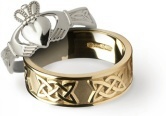Blog Categories
Blog CategoriesSaint Valentine's Day and Ireland
History of Saint Valentine
In ancient Rome, February the 14th was marked the feast day of Juno, the Goddess of women and marriage. The day after was another pagan Roman festival known as Lupercalia, where young single men and women that lived strictly separated from each other would come together in the hope that love would flourish. So it was a custom on Valentine's night for all the maidens’ names to be put in a jar and picked by the young men as partners for the feast. Sometimes the pairing lasted up to a year with the couple falling in love and eventually marrying.
However, with the new emperor Claudius taking rule, the teenage match making feast came to an abrupt end. Claudius was a cruel war waging emperor, made unpopular with his troops by continually ordering them into needless battles. It isn’t a surprise that he had difficulty recruiting soldiers for military action and he irrationally put it down to the influence of women. He then banned all future and pending marriage or engagements in Rome and also made it punishable by death to even associate with Christians.
Legend has it that Valentine, who was a Christian priest, was saddened by the marriage ban, believing that the souls of the lovers would be destined for sin. So he defied Claudius' decree and married young couples in secrecy. Sadly, he was eventually caught and punished for the laws he broke and sentenced to death.
It’s not entirely clear what year he suffered martyrdom, either 269 or 270 AD, but the day was 14th of February which from then on was known as Saint Valentine’s Day.

Saint Valentine and Ireland
Us Irish are famous for our romantic spirit, being home to many romantic poets and musicians. It is even said that the earthly remains of Saint Valentine himself are believed to rest in Whitefriar Street Church in Dublin. It is said that in 1836 the appointed pope, Gregory XVI, sent a gift to this church in Dublin as recognition of the church's previous prior, Father John Spratt, well known as a good and very holy man. The gift was a relic of a Christian martyr contained in a small gold casket. The remains were those of Saint Valentine!
Even to this day on February 14th there is a special mass to honor the saint. Couples come to visit the shrine and this understated church even sells Valentine’s cards to celebrate the day.
On Valentine’s Day all over Ireland there are many other rituals and customs to commemorate the day, adding a little Irish spirit to the celebrations. Among them are the tradition of exchanging Claddagh rings, the Irish token of love. These rings can also be used as wedding or engagement rings and are worn by both men and women.
The Claddagh can be used to show your status in the pursuit of love. Here is a guide to wearing a Claddagh ring:
- If you wear a Claddagh ring on your right hand with the point of the heart facing out, it lets others know that your heart is open and you are looking to be approached.
- If you wear the ring on the right hand but this time the heart is pointing in towards your own, it means your heart has been taken and you are seeing someone.
- If the Claddagh is worn on the left hand with the heart pointing outwards, this lets others know that you are engaged to be married.
- And if the Claddagh is worn on the left hand with the heart facing inwards towards your own, it is a sign you are married.
